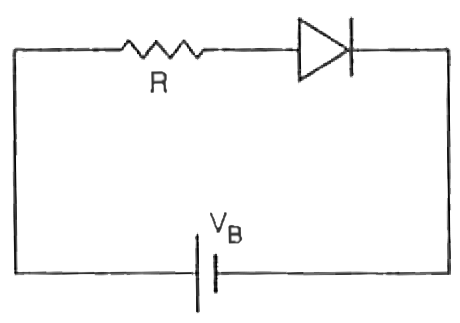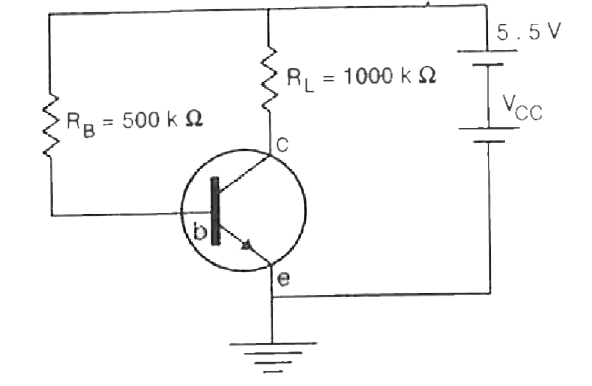Complete Solutions to Exercises of chapter DIODE, TRIODE & TRANSISTER of Class 12 book with complete answers and questions
| Class 12 | PHYSICS |
| Chapter | DIODE, TRIODE & TRANSISTER |
| NN GHOSH | Exercises |
| Number Of Questions | 19 |
| Academic Year | 2023-24 |
A diode has Child's constant `K =0.2` (current in mA and voltage in volts). Calculate the voltage across the tube, across a load of resistance `10000 Omega` and source the voltage when the tube produces a current of `12.8` mA through the load.
View SolutionIn a certain triode, the output is 5 mA with an anode potential of 200 V and grid potential `-3V`. When he potential is increased to 260 V, the current rises `10.7 mA`. A charge in grid voltage to `-4V` restores the current to the original value. Find the constant of the valve
View SolutionA triode valve of anode slope resistance `20 kOmega` is used with an anode load resistance of `50 kOmega`. If an alternating signal of 0.5 V (rms value) is applied to the grid, find the output if the amplification factor of the valve is 15.
View SolutionThe voltage of a triode amplifier with a resistive load of `5 kOmega` is 10 while with a resistive load of `12 kOmega`. It is 15. Calculate the amplification factor and plate resistance of the triode.
View SolutionThe plate resistance of a triode is `7.7 kOmega`, and the transconductanace is 2.6 millimho. If only the plate voltage is increased by 50 V, what is the increase in the plate current ? What change in grid voltage will now bring the plate current to its former value ?
View SolutionDetermine the conductivity of pure germanium at `27^(@)C`. The concentration of the carriers at this temperature is `2.2 xx 10^(19)m^(-3)`. The mobility of electrons = 0.36 and that of holes = 0.17
View SolutionIn a p-n junction diode the reverse saturation current is `10 muA`. What will be the forward current for a voltager of 0.2 V ?
View SolutionAssume that the silicon diode in the given circuit requires a minimum current of 1 mA to be above the (knee-point voltage = 0.7 V) of its `I-V` characteristics. Assuming that the voltage across the diode is independent of current above the knee-point, find the maximum value of R so that the voltage is above the knee-point if `V_(B) = 5A`. Also find the value of R to establish a current of 5 mA in the circuit for the since voltage.

View SolutionThe base current of a transistor is `105 muA` and the collector current is 2.05 mA. Determine the alue of `beta,I_(C) and alpha`. If a change of `27 muA` in the base current produces a change of 0.65 mA in the collector, find `beta_(ac)`.
View SolutionIn a silicon transistor, a change of 7.89 mA in the emitter current produces a change of 7.89 mA in the collector current. What change in the base current will bring the same change in the collector current ?
View SolutionIn a silicon transistor the base current is changed by `20 mu A`. This results in a change of 0.02 V in the base to emitter voltage and a changed of 2 mA in the collector current
(a) Find the input resistance `r_(b),beta_(ac)` and transconductance `g_(m)` of the transistor
(b) The transistor is used as an amplifier with a load resistance of `5 kOmega`. What is the voltage gain of the amplifier ?
View SolutionIn triode valve, for a grid voltage `V_(g) = -1.2 V`, the plate current `I_(p)` (in mA) ad the plate voltage are given by the relation `I_(p) = -50 +0.1 V_(p)`, when the grid voltage is changed to `-3.2 V` and the plate voltage is kept at 150 V, plate current of 5 mA is observed. Calculate the valve constant and the voltage amplification for `20 k Omega` load in the plate circuit.
View SolutionIn the accompanying circuit (Fig. 5.9) the value of `beta` is `100`. Find `I_(B),V_(CE),V_(CE)` and `V_(BC)`, when `I_(C) =1.5 mA`. Is the transistor in active, cut-off or saturation state ?

View SolutionIn the accompanying circuit Fig. 5.10, if it is assumed that when that input voltage at the base resistance is 5 V, `V_(BE)` is zero and `V_(CE)` is also zero, what are `I_(B),I_(C) and beta` ? When the input is zero, `I_(B)` is zero. What will be the output waveform if the input waveform is as shown in the figure ? What is the practial use of this current ?

View SolutionIn the given circuit Fig. 5.11, the base current is `10 muA` and the collector current is 52 mA. Can this transistor be used as an amplifier ?
View SolutionIn the given circuit (Fig. 5.12) calculate the value of the collector current if its `I_(CD) = 10 muA and alpha = 0.97`. Assume a voltage drop between base and emitter of 0.15 V
[Hint : `I_(C)=alpha I_(C)+I_(CO)`]

View SolutionCalculate the emiter current and collector voltage of the circuit given in Fig. 5.13
View SolutionA transistor connected in common emitter configuration has `V_(C C)=8V, V_(L) = 0.5 V` and `R_(L) = 800 Omega`. If its `alpha = 0.96` determine (i) collector emitter voltage, (ii) its base current.
View SolutionIn a transistor collector load is `4 kOmega` whereas the zero signal current is 1 mA. (a) What is the operating point if `V_(C C) = 10 V` ? (b) What will be the operating point if `R_(L) = 5 kOmega` ?
[Hint : Operating point is zero signal collectorm current and `V_(CO)`]
View Solution
Exercises questions and complete solutions for chapter DIODE, TRIODE & TRANSISTER of NN GHOSH PHYSICS (HINGLISH) of Class 12